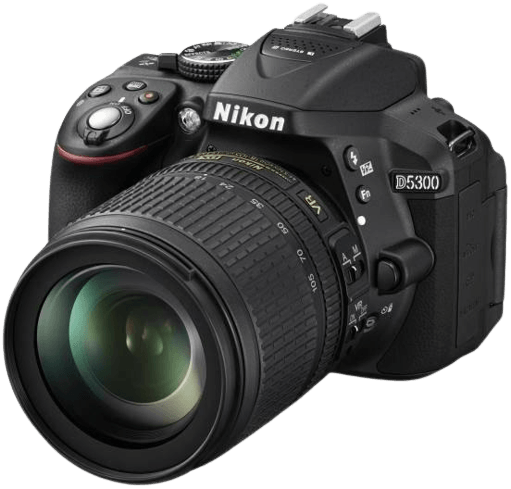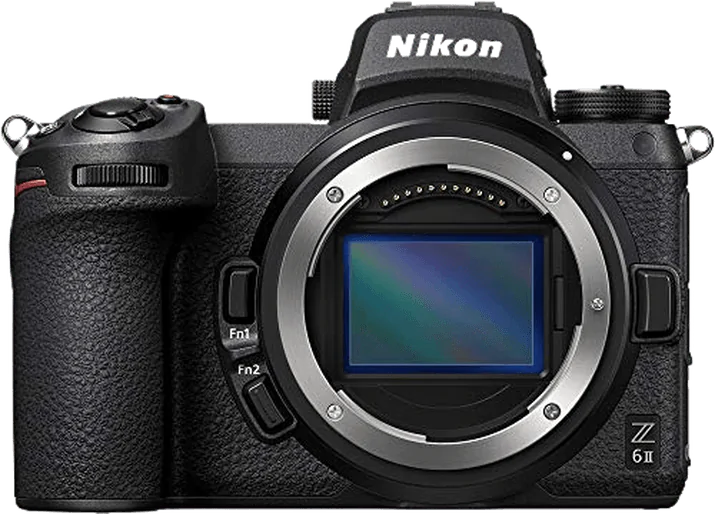Nikon D5300 vs Z6 II Comparison
Nikon D5300

Nikon Z6 II

The Nikon Z6 II emerges as the winner with a score of 83/100, while the Nikon D5300 trails behind with a score of 57/100. Both cameras share similarities such as being manufactured by Nikon and having different body types: the D5300 is a DSLR, and the Z6 II is a mirrorless camera. Both were announced in October, with the D5300 in 2013 and the Z6 II in 2020.
The Z6 II excels with its higher score, more recent release, and a launch price of $1995, reflecting its advanced features. On the other hand, the D5300 is a more affordable option at $800, making it suitable for those on a budget. The Z6 II is larger and heavier, measuring 134 x 101 x 70mm and weighing 705g, while the D5300 is smaller and lighter at 125 x 98 x 76mm and 480g.
Considering these factors, the Nikon Z6 II is the superior camera with its higher score and advanced features. However, the Nikon D5300 offers a more budget-friendly option for those looking for a smaller and lighter DSLR camera.
Nikon D5300 vs Z6 II Overview and Optics
The Nikon Z6 II outperforms the Nikon D5300 in optics, with a score of 83/100, an 18-point difference from the D5300’s score of 65/100. Both cameras share common specifications, including 24-megapixel CMOS sensors and Nikon lens mounts. However, the Z6 II excels in several areas, making it the superior choice for photographers prioritizing optical performance.
The Z6 II has a faster shooting speed of 14 frames per second, compared to the D5300’s 5 frames per second. This increased speed allows photographers to capture fast-moving subjects with greater ease. Additionally, the Z6 II benefits from a dual Expeed 6 processor, which contributes to the camera’s improved performance. Its full-frame sensor also provides better image quality, as evidenced by its DXOMARK score of 94, compared to the D5300’s score of 83. Furthermore, the Z6 II features image stabilization, which helps reduce camera shake and blur in images.
On the other hand, the D5300 has an APS-C sensor, which is smaller than the Z6 II’s full-frame sensor. While this may be a drawback for some photographers, the smaller sensor size could be an advantage for those who prefer a lighter and more compact camera. The D5300 also uses the Nikon F DX lens mount, which is compatible with a wide range of lenses.
In comparing the optics of the Nikon D5300 and Z6 II, the Z6 II clearly offers superior performance, with its faster shooting speed, dual Expeed 6 processor, full-frame sensor, and image stabilization. While the D5300 may be more compact and compatible with a larger selection of lenses, it falls behind the Z6 II in terms of optical capabilities. Therefore, photographers seeking enhanced optics should opt for the Nikon Z6 II.
Nikon D5300 vs Z6 II Video Performance
The Nikon Z6 II outperforms the Nikon D5300 in video capabilities with a score of 91/100, a significant 21-point lead over the D5300’s 70/100. Both cameras share some common features, such as built-in time-lapse functionality, allowing for creative video applications. However, the Z6 II surpasses the D5300 in several key aspects, making it the superior choice for videographers.
One major advantage of the Nikon Z6 II is its 4K video resolution, which is a notable improvement over the D5300’s Full HD resolution. This results in crisper, more detailed video footage, as the Z6 II’s maximum video dimensions are 3840 x 2160, compared to the D5300’s 1920 x 1080. Additionally, the Z6 II boasts a higher maximum video frame rate of 120fps, doubling the D5300’s 60fps. This allows for smoother slow-motion video capture and increased flexibility in post-production.
While the Nikon D5300 lags behind the Z6 II in most aspects, it still offers solid video performance for its class. Its Full HD resolution and 60fps frame rate are suitable for casual videographers and those not requiring the advanced capabilities of the Z6 II. This makes the D5300 a more budget-friendly option for those whose primary focus is not video production.
Considering the significant differences in video capabilities, the Nikon Z6 II is the clear winner for videographers seeking higher resolution, increased frame rate, and overall better performance. The Nikon D5300 remains a viable option for casual users or those on a tighter budget, but the Z6 II’s superior video features make it the top choice for professionals and serious enthusiasts.
Nikon D5300 vs Z6 II Features and Benefits
The Nikon Z6 II emerges as the winner in the feature comparison with a score of 87 out of 100, while the Nikon D5300 scores 46 out of 100. Both cameras share some specifications, such as a 3.2-inch screen size and built-in WiFi connectivity. However, the Nikon Z6 II surpasses the D5300 in several aspects, making it a better camera overall.
The Z6 II’s screen resolution is significantly higher at 2,100,000 dots, compared to the D5300’s 1,037,000 dots. This means that the Z6 II offers a sharper and more detailed display for image preview and menu navigation. Additionally, the Z6 II is equipped with a touchscreen, making it more user-friendly and efficient to use. The camera also features Bluetooth connectivity, allowing for seamless file transfer and remote control.
On the other hand, the D5300 has some advantages over the Z6 II. It includes a flip screen that enables users to capture images and videos from different angles with ease. This feature is particularly useful for vlogging and self-portraits. The D5300 also has a built-in GPS, which allows for automatic geotagging of photos, making it easier to organize and locate images based on location.
In terms of features, the Nikon Z6 II is a superior camera with a higher-resolution screen, touchscreen capabilities, and Bluetooth connectivity. However, the Nikon D5300 offers a flip screen and GPS functionality, which may appeal to certain users. Considering the overall scores and specifications, the Nikon Z6 II is the better choice for those prioritizing advanced features and image quality, while the Nikon D5300 may be suitable for users who value a flip screen and GPS capabilities.
Nikon D5300 vs Z6 II Storage and Battery
The Nikon Z6 II outperforms the Nikon D5300 in storage and battery with a score of 71/100, while the D5300 scores 29/100. Both cameras accept SD memory cards, but the Z6 II has two memory card slots and also supports CFexpress Type B / XQD (UHS-II compatible) cards. The D5300 has only one slot for SD / SDHC / SDXC cards.
The Z6 II offers the advantage of USB charging, making it more convenient for on-the-go photographers. However, the D5300 has a longer battery life, providing 600 shots per charge compared to the Z6 II’s 410 shots. The D5300 uses the EN-EL14a battery, while the Z6 II uses the EN-EL15c battery.
Despite the D5300’s longer battery life, the Z6 II’s superior storage options and USB charging capability make it the better choice in this category. The D5300’s advantage in battery life may be beneficial for some users, but overall, the Z6 II offers more versatility and convenience in storage and battery.
Nikon D5300 vs Z6 II – Our Verdict
Are you still undecided about which camera is right for you? Have a look at these popular comparisons that feature the Nikon D5300 or the Nikon Z6 II:

